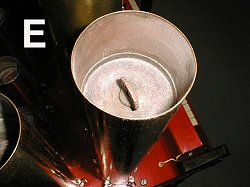TANGLEY CALLIOPE RESTORATION PROJECT (part 37)
by Dr. Bill Black
TUNING THE PIPEWORK
Now that the calliope is finished and the various functions adjusted, will can tune the pipework. PHOTO A show the roll chuck for the music roll. The end of the metal rod is threaded to match the flange. This arrangement is spring loaded to put pressure on the flange in an outward direction. When the music roll is placed on the chuck, the flange end can be screwed onto the rod until it contacts the edge of the roll.
 
PHOTO B shows the music test roll in place in the roll frame. Since the Calliope plays the same music roll format as the 65 note automatic player piano A roll, the test roll can be used for both machines. The roll can be advanced by hand one note at a time to play individual pipes one at a time.
My favorite tuner is the Conn Strobotuner (PHOTO C). Its an old tube operated machine which has a nice visual display of the pitch and works very well. Having placed the test roll on the machine, we begin to test each pipe with the strobe to see if there is an average pitch setting for the strobe for the whole set of pipes so that we can adjust the pipework to this average. That way we can sort of pull the pitch of each pipe to that average setting without having to make major adjustments on each pipe. These stoppers are rather tight in the pipe and do not tend to move easily so some pipes were still in tune and did not need to be changed.
 
The pipes are tuned by raising or lowering the metal stopper in the top of the pipe. PHOTO D shows the tool which is used for this purpose. The tool was made by the previous owner using a bracket from a coat rack. The bracket was drilled and tapped for a thread to match the treaded rod.
The end of the rod has a hook which can engage a metal loop on the top of each stopper (PHOTO E) . By placing the hook in the loop and placing the large washer of the tool on top of the pipe (PHOTO F), the stopper can be raised in the pipe by winding the bracket down against the washer. The extended part of the bracket is easy to get a hold of to turn. Raising
the stopper lowers the pitch of the note the pipe plays. There is also a smaller tool to be used on the small pipes. If you need to raise the pitch of the pipe, the stopper is tapped downward in the pipe. By setting the strobe to the pitch you want the pipe to play and raising or lowering the stopper, the pipe is tuned to the indicated pitch on the strobe.
 
Each pipe has the pitch adjusted to the indicated note setting on the strobe. I indicated on the music roll the note which is being played so the strobe can be set to the correct note.
Next month, its finished.
 Dr. Bill Black is one of the nation's most knowledgeble Wurlitzer band organ experts. He has made recordings of many band organs and other mechanical music machines which are available for purchase in our CarouselStores. Dr. Bill Black is one of the nation's most knowledgeble Wurlitzer band organ experts. He has made recordings of many band organs and other mechanical music machines which are available for purchase in our CarouselStores.
|